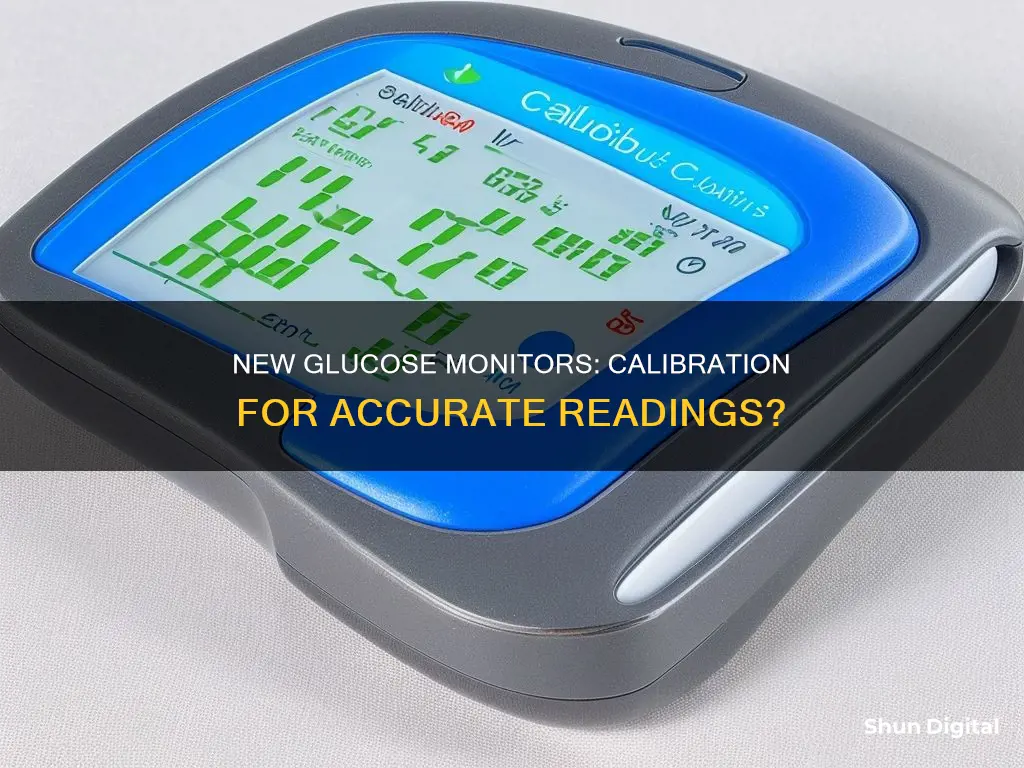
Glucose monitors are a wearable technology that helps people with diabetes manage their blood sugar levels. The monitor consists of a sensor, transmitter, and a smartphone app, receiver, or insulin pump. The sensor is placed under the skin and measures glucose levels in the interstitial fluid. The transmitter sends the data to the receiver, which displays the glucose level and its trend. While some glucose monitors start sharing data automatically, others require a fingerstick blood glucose calibration. Calibration is also necessary when the monitor gives questionable readings.
| Characteristics | Values |
|---|---|
| Purpose | To manage diabetes with fewer fingerstick checks |
| Components | Sensor, transmitter, smartphone app/receiver/insulin pump |
| Sensor Placement | Under the skin, usually on the belly or arm |
| Sensor Lifespan | 7-15 days; implantable CGM systems can last for months |
| Calibration | Some CGMs require fingerstick blood glucose calibration |
| Data Transfer | Data can be downloaded to a computer or shared with a healthcare provider |
| Limitations | Issues with adhesives, allergic reactions, cost, information overload, alarm fatigue |
What You'll Learn
- How does a new glucose monitor work?
- How often do you need to calibrate a new glucose monitor?
- What are the pros and cons of using a new glucose monitor?
- How do you calibrate a new glucose monitor?
- What is the difference between calibrating a new glucose monitor and a traditional fingerstick blood glucose check?

How does a new glucose monitor work?
A continuous glucose monitor (CGM) is a device that helps people manage their diabetes by tracking their glucose (or blood sugar) levels. It consists of three main components: a sensor, a transmitter, and a smartphone app, receiver, or insulin pump.
The sensor is a tiny piece of material that is inserted just under the skin, usually on the belly or arm, using an applicator and adhesive tape to keep it in place. This sensor measures glucose levels in the interstitial fluid between your cells, which is very similar to the glucose level in your blood. The sensor must be replaced every few weeks, depending on the type and brand.
The transmitter is the second part of the CGM. It wirelessly sends the glucose data from the sensor to a device where the information can be viewed. In most CGMs, the transmitter is reusable and attaches to each new sensor, while in others, it is part of the disposable sensor.
The third part of the CGM is a smartphone app, a separate receiver device, or an insulin pump, which displays the real-time glucose level and shows a graph of the history of glucose levels. This technology can also show whether the glucose level is trending up or down and how drastic the change is. Some CGMs can also send glucose information to a compatible insulin pump.
After inserting the sensor, there is typically a “warm-up” time of 30 minutes to two hours before the sensor starts sharing data. Some CGMs require a fingerstick blood glucose calibration before sharing data, while others start automatically. The sensor typically lasts seven to 15 days, after which the process must be started again with a new sensor.
CGMs provide valuable real-time data that can help people with diabetes make more informed decisions about their medication, nutrition, and physical activity to regulate their blood sugar levels effectively.
Starbucks Performance: Who Watches the Watchers?
You may want to see also

How often do you need to calibrate a new glucose monitor?
The frequency with which you need to calibrate a new glucose monitor depends on the type of device and the manufacturer's instructions. Some devices may require calibration every 12-24 hours, while others may have different calibration schedules. It is important to refer to the specific instructions provided with your glucose monitor to determine the recommended calibration frequency.
In general, calibration is necessary to ensure the accuracy of the glucose readings. Glucose monitors measure the electrical current generated by the glucose-oxidase reaction and convert it into a glucose concentration value through a calibration process. This process involves using a calibration algorithm or function that relates the electrical current signal to the glucose concentration.
There are various techniques used for calibration, including simple linear regression, more sophisticated signal processing methods, and machine-learning algorithms. The choice of the calibration technique depends on factors such as the desired accuracy, computational complexity, and user acceptability.
Additionally, it is important to note that control solution tests are different from calibration and are used to check if the meter and test strips are reading blood sugar levels properly. Control solution tests can be performed when you first receive or purchase the meter, when using a new vial of test strips, or when you suspect that the meter or test strips are not working properly, among other reasons.
Yamaha NS-10s: Unlikely Studio Standard
You may want to see also

What are the pros and cons of using a new glucose monitor?
Pros of Using a New Glucose Monitor:
- They provide real-time blood sugar readings 24 hours a day, allowing people with type 1 or type 2 diabetes to closely track blood glucose levels and trends.
- They can help people with diabetes make informed decisions about food choices, exercise, and other aspects of diabetes management by alleviating much of the guesswork about daily patterns and fluctuations.
- They can help detect trends in blood glucose levels, even if the measurements are not entirely precise.
- They eliminate the need for numerous finger pricks, which may be painful and difficult to manage frequently.
- They help to clarify the effect of diet and exercise on blood sugar levels.
- They can alert users with an alarm when glucose levels are too low or too high.
- They can be used with insulin pump therapy.
- They can be set up to give an alert on a preselected glucose level.
- They are especially practical for use in the pediatric population.
Cons of Using a New Glucose Monitor:
- They are prescription-only and expensive, with initial costs ranging from $1,000 to $2,000.
- Supplies can cost between $300 and $450 per month, including sensors that should be replaced every seven to 14 days.
- They usually require twice-daily finger sticks to calibrate the device for accuracy.
- They can take about five to 25 minutes longer to show a rise in glucose readings compared to venous blood glucose.
- There is data to suggest they may become increasingly inaccurate at detecting hypoglycemia (low glucose) ranges.
- They may be difficult to troubleshoot when problems arise with the readers' functionality.
- The sensor does not always stay on, and once it falls off, it should not be reinserted into the patient’s body.
Is Your Computer Monitored? Signs to Watch Out For
You may want to see also

How do you calibrate a new glucose monitor?
Calibration is a process that ensures a continuous glucose monitor (CGM) provides accurate glucose readings. Calibrations can be done by the manufacturer, the person wearing the CGM, or both. Here is a step-by-step guide on how to calibrate a new glucose monitor:
Step 1: Prepare Testing Supplies
Ensure your testing supplies are stored at a cool temperature and check that your test strips have not expired before use.
Step 2: Wash Your Hands
Wash your hands using soap, water, or alcohol to prevent anything from causing an inaccurate reading.
Step 3: Check Blood Glucose Level
Check your blood glucose level using your meter, only pricking your fingertips to draw blood.
Step 4: Enter Blood Glucose Value
Enter the blood glucose value into your CGM receiver, insulin pump, or phone app.
Step 5: Calibrate CGM
Enter the calibration data into the CGM receiver or pump as soon as possible, as glucose levels are constantly changing.
It is best to calibrate when blood glucose levels are stable, which is usually first thing in the morning or before meals. Avoid calibrating when glucose levels are changing quickly, such as after eating, taking insulin, or exercising.
Additionally, if there is a difference of more than 20% between blood glucose and sensor glucose, wait to calibrate.
Step 6: Medication Considerations
Be aware that certain medications may lead to inaccurate CGM readings, including:
- Vitamin C/ascorbic acid doses higher than 500 mg
- Hydroxyurea, acetaminophen, and paracetamol (may affect Dexcom sensors)
- Tetracycline (may affect Eversense sensors)
Step 7: Calibration Frequency
The calibration frequency depends on the CGM model. Some models, such as the Dexcom G6, Libre, and Libre 2.0, do not require daily calibrations. Other models, like the Medtronic Guardian Connect, require calibration every 12 hours (2-3 times per day). The Eversense CGM requires four calibrations 2-12 hours apart initially, then two calibrations daily for the first 21 days, and one calibration daily thereafter.
Charging Your Sentinel Ankle Monitor: A Step-by-Step Guide
You may want to see also

What is the difference between calibrating a new glucose monitor and a traditional fingerstick blood glucose check?
Calibrating a new glucose monitor and a traditional fingerstick blood glucose check are two different processes that serve the same purpose of tracking an individual's glucose levels. Here are the key differences between the two methods:
Traditional Fingerstick Blood Glucose Check:
- A traditional fingerstick blood glucose check involves pricking the fingertip to obtain a blood sample and then placing it on a test strip that is inserted into a glucose meter.
- This method provides a measurement of the individual's glucose level at that specific moment in time.
- Fingerstick testing is generally considered the most accurate way to determine one's glucose level.
- It is a simple and long-used method, but it can be uncomfortable and may require multiple tests throughout the day to get a complete picture of glucose management.
Calibrating a New Glucose Monitor (CGM):
- A continuous glucose monitor (CGM) is a device that measures glucose levels in the fluid under the skin, known as interstitial fluid, rather than directly measuring blood glucose.
- The user inserts a tiny sensor under the skin of the belly or arm, which stays in place for several days and continuously collects glucose samples.
- The data from the CGM sensor is transmitted to a receiver, smartphone app, or insulin pump, providing real-time glucose readings and trends.
- CGMs can reduce the frequency of fingerstick tests and provide more comprehensive data for managing diabetes, but they still require periodic calibration with traditional fingerstick tests.
- CGMs can be more technically complex to use and may be more expensive due to the need for regular sensor replacements.
- The accuracy of CGMs can be affected by various factors, including calibration, sensor chemistry, and individual body chemistry.
Kia Rio's Blind Spot Monitoring: Is It Worth the Hype?
You may want to see also
Frequently asked questions
Yes, you have to calibrate a new glucose monitor. Calibration is necessary to convert the raw measurements from the monitor into glucose values.
The calibration frequency depends on the specific glucose monitor in use. Some glucose monitors require calibration at least every 12 hours, while others may have different calibration requirements. It is important to refer to the manufacturer's instructions for the specific calibration needs of your device.
The calibration process involves inserting a new test strip into the glucose meter and performing a test using a glucose control solution. The result obtained from the control solution test is then compared to the range specified by the manufacturer to ensure the meter is functioning correctly.
Calibration is essential to ensure the accuracy and reliability of the glucose monitor. It helps to compensate for factors such as sensor drift, variations in sensor sensitivity, and the complex nonlinear relationship between the measured electrical current and glucose concentration.







